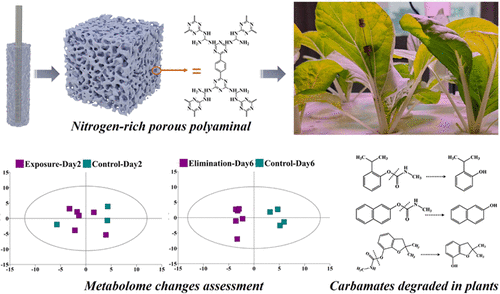当前位置:
X-MOL 学术
›
Environ. Sci. Technol.
›
论文详情
Our official English website, www.x-mol.net, welcomes your
feedback! (Note: you will need to create a separate account there.)
In Vivo Contaminant Monitoring and Metabolomic Profiling in Plants Exposed to Carbamates via a Novel Microextraction Fiber
Environmental Science & Technology ( IF 10.8 ) Pub Date : 2021-09-08 , DOI: 10.1021/acs.est.1c04368 Shuqin Liu 1 , Yiquan Huang 1 , Jian Liu 2 , Chao Chen 1 , Gangfeng Ouyang 1, 3
Environmental Science & Technology ( IF 10.8 ) Pub Date : 2021-09-08 , DOI: 10.1021/acs.est.1c04368 Shuqin Liu 1 , Yiquan Huang 1 , Jian Liu 2 , Chao Chen 1 , Gangfeng Ouyang 1, 3
Affiliation

|
In this study, a biocompatible solid-phase microextraction (SPME) fiber with high-coverage capture capacity based on a nitrogen-rich porous polyaminal was developed. The fiber was used to track the bioaccumulation and elimination of carbamates (isoprocarb, carbofuran, and carbaryl) and their metabolites (o-cumenol, carbofuran phenol, and 1-naphthalenol) in living Chinese cabbage plants (Brassica campestris L. ssp. chinensis Makino (var. communis Tsen et Lee)). A case-and-control model was applied in the hydroponically cultured plants, with the exposed plant groups contaminated under three carbamates at 5 μg mL–1. Both bio-enrichment and elimination of carbamates and their metabolites in living plants appeared to be very fast with half-lives at ∼0.39–0.79 and ∼0.56–0.69 days, respectively. Statistical differences in the endogenous plant metabolome occurred on day 3 of carbamate exposure. In the exposed group, the plant metabolic alterations were not reversed after 5 days of contaminant-free growth, although most contaminates had been eliminated. Compared with prior nutriological and toxicological studies, >50 compounds were first identified as endogenous metabolites in cabbage plants. The contents of the glucosinolate-related metabolites demonstrated significant time-dependent dysregulations that the fold changes of these key metabolites decreased from 0.78–1.07 to 0.28–0.82 during carbamate exposure. To summarize, in vivo SPME provided new and important information regarding exogenous carbamate contamination and related metabolic dysregulation in plants.
中文翻译:

通过新型微萃取纤维对暴露于氨基甲酸酯的植物进行体内污染物监测和代谢组学分析
在这项研究中,开发了一种基于富氮多孔聚胺的具有高覆盖率捕获能力的生物相容性固相微萃取 (SPME) 纤维。该纤维用于追踪活的大白菜植物 ( Brassica campestris L. ssp. chinensis Makino ) 中氨基甲酸酯(异丙威、呋喃丹和西维因)及其代谢物(邻异丙苯、呋喃苯酚和 1-萘酚)的生物积累和消除(品种群落芥))。案例对照模型应用于水培植物,暴露植物组被三种氨基甲酸酯污染,浓度为 5 μg mL –1. 活植物中氨基甲酸酯及其代谢物的生物富集和消除似乎非常快,半衰期分别为~0.39-0.79 天和~0.56-0.69 天。内源性植物代谢组的统计差异发生在氨基甲酸酯暴露的第 3 天。在暴露组中,尽管大多数污染物已被消除,但在无污染生长 5 天后,植物代谢改变并未逆转。与之前的营养学和毒理学研究相比,超过 50 种化合物首次被鉴定为卷心菜植物的内源性代谢物。硫代葡萄糖苷相关代谢物的含量显示出显着的时间依赖性失调,这些关键代谢物的倍数变化在氨基甲酸酯暴露期间从 0.78-1.07 减少到 0.28-0.82。总结一下,
更新日期:2021-09-21
中文翻译:

通过新型微萃取纤维对暴露于氨基甲酸酯的植物进行体内污染物监测和代谢组学分析
在这项研究中,开发了一种基于富氮多孔聚胺的具有高覆盖率捕获能力的生物相容性固相微萃取 (SPME) 纤维。该纤维用于追踪活的大白菜植物 ( Brassica campestris L. ssp. chinensis Makino ) 中氨基甲酸酯(异丙威、呋喃丹和西维因)及其代谢物(邻异丙苯、呋喃苯酚和 1-萘酚)的生物积累和消除(品种群落芥))。案例对照模型应用于水培植物,暴露植物组被三种氨基甲酸酯污染,浓度为 5 μg mL –1. 活植物中氨基甲酸酯及其代谢物的生物富集和消除似乎非常快,半衰期分别为~0.39-0.79 天和~0.56-0.69 天。内源性植物代谢组的统计差异发生在氨基甲酸酯暴露的第 3 天。在暴露组中,尽管大多数污染物已被消除,但在无污染生长 5 天后,植物代谢改变并未逆转。与之前的营养学和毒理学研究相比,超过 50 种化合物首次被鉴定为卷心菜植物的内源性代谢物。硫代葡萄糖苷相关代谢物的含量显示出显着的时间依赖性失调,这些关键代谢物的倍数变化在氨基甲酸酯暴露期间从 0.78-1.07 减少到 0.28-0.82。总结一下,









































 京公网安备 11010802027423号
京公网安备 11010802027423号